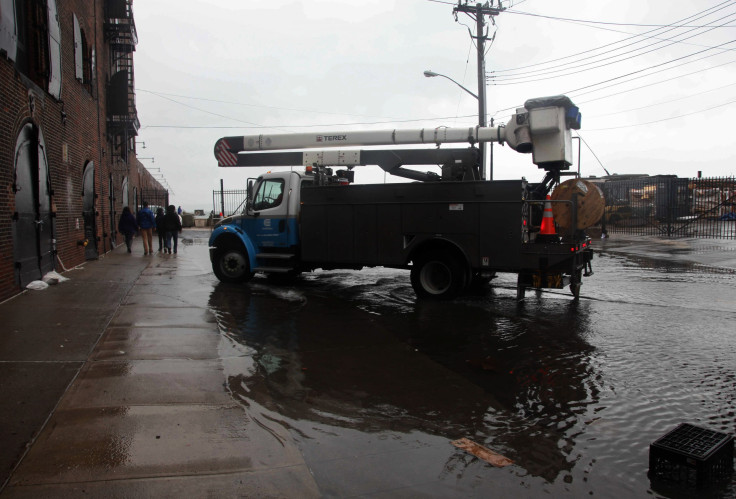Hurricane Sandy Update: At Least 33 Killed, Millions Without Power [LATEST OUTAGES]

Though weather is much calmer along the U.S. East Coast on Tuesday, Hurricane Sandy killed at least 33 people in several states and left approximately 6 million people along the coast without power.
Many of those deaths resulted from fallen trees, according to the Associated Press. At least seven of those deaths were reported in the New York region, according to the New York Times.
Sandy, which has now downgraded to a storm, lashed much of the mid-Atlantic region, flooding buildings, streets and closing down mass transit systems in New York – hours after touching down in New Jersey with 80 mph winds on Monday evening.
New York City’s MTA Chairman Joseph J. Lhota on Tuesday called the flooding from Sandy the worst in the subway system’s 108-year history.
“Hurricane Sandy wreaked havoc on our entire transportation system, in every borough and county of the region,” Lhota said in a statement. “It has brought down trees, ripped out power and inundated tunnels, rail yards and bus depots.”
Here’s Lhota’s account of the damage so far:
“As of last night, seven subway tunnels under the East River flooded. Metro-North Railroad lost power from 59th Street to Croton-Harmon on the Hudson Line and to New Haven on the New Haven Line. The Long Island Rail Road evacuated its West Side Yards and suffered flooding in one East River tunnel. The Hugh L. Carey Tunnel is flooded from end to end and the Queens Midtown Tunnel also took on water and was closed. Six bus garages were disabled by high water. We are assessing the extent of the damage and beginning the process of recovery. Our employees have shown remarkable dedication over the past few days, and I thank them on behalf of every New Yorker. In 108 years, our employees have never faced a challenge like the one that confronts us now. All of us at the MTA are committed to restoring the system as quickly as we can to help bring New York back to normal. “
New Jersey’s Damage ‘Almost Incalculable’
New Jersey, which has more than 2 million people without power, took a direct hit from Sandy.
Gov. Chris Christie told NCB’s “Today” on Monday that the conditions in the state is “a major disaster.” (See Christie's interview above.)
“We have a battered, battered New Jersey shore that I hope to tour a little bit later on today, but I think the losses are going to be almost incalculable,” he said.
Search and rescue mission is already underway in Atlantic City and other such missions are present throughout the state. Christie said so far there have been three death in New Jersey.
President Barack Obama has already declared a disaster for New Jersey and New York, freeing up federal aid to expedite recovery efforts.
Christie said he has been in constant contact with Obama and praised his handling of the situation.
“The president has been outstanding in this, and so the folks of FEMA, Craig Fugate and his folks have been excellent,” Christie said.
A Record For ConEd
It is not only the New York subways that is experiecing historic problems.
Con Edison said more than 650,000 customers in New York City and Westchester County have lost power because of Hurricane Sandy.
"This is the largest storm-related outage in our history," said Con Edison Senior Vice President for Electric Operations John Miksad.
The power company said the previous record was more than 200,000 customers when Hurricane Irene battered the East Coast in 2011.
Miksad said ConEd crews must assess damage before repair gets underway and that low-lying areas of New York City and Westchester County are still under water.
More than 200 wires are down on Staten Island. In Westchester County, more than 180 roads are closed. ConEd said restoring electrical service to underground equipment calls for the cleaning of all components of seawater, then drying and testing them so it is safe to restore power.
Latest Outages In NYC as of Tuesday AM:
Manhattan: 193,000 customers
Westchester County: 158,000 customers
Queens: 74,000 customers
Brooklyn: 71,000 customers
Staten Island: 76,000 customers
Bronx: 38,000 customers
© Copyright IBTimes 2024. All rights reserved.












